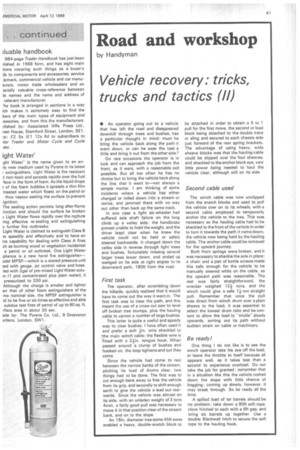Road and workshop
Page 43

If you've noticed an error in this article please click here to report it so we can fix it.
by Handyman
Vehicle recovery: tricks, trucks and tactics (II)
• An operator going out to a vehicle that has left the road and disappeared downhill through trees and bushes, has a particular thought in mind: must he bring the vehicle back along the path it went down, or can he ease the task a little and bring it out from the other side ?
On rare occasions the operator is in luck and can approach the job from the front, as it were, with a reasonable exit possible. But all too often he has no choice but to bring the vehicle back along the line that it went in—not always a simple matter. I am thinking of some incidents where a vehicle has either charged or rolled down into a stream or ravine, and jammed there with no way out other than back up the same track.
In one case a light six-wheeler had suffered axle shaft failure on the long climb up a valley side; the handbrake proved unable to hold the weight, and the driver leapt clear when he knew the vehicle could not be held or safely steered backwards. It charged down the valley side in reverse through light trees and bushes, fortunately missing several larger trees lower down, and ended up wedged on its side at right angles to its downward path, 180ft from the road.
First task
The operator, after scrambling down the hillside, quickly realized that it would have to come out the way it went in. The first task was to clear the path, and this meant the use of a cross-cut saw to level off broken tree stumps, plus the hauling cable to uproot a number of large bushes.
This latter is quite a useful and speedy way to clear bushes. I have often used it and prefer a soft lin, wire shackled to the main winch cable: the flexible wire is fitted with a 21in, tongue hook. When passed around a clump of bushes and hooked on, the loop tightens and out they Come.
Since the vehicle had come to rest between the narrow banks of the stream, pitching its load of drums clear, two things had to be done. The first was to cut enough bank away to free the vehicle from its grip, and secondly to shift enough earth to give the vehicle a lead out rearwards. Since the vehicle was almost on its side, with an unladen weight of 3 tons 4cwt, a fairly good pull was necessary to move it in that position clear of the stream bank, and on to the slope.
An 18in. diameter tree some 45ft away enabled a heavy, double-snatch block to be attached in order to obtain a 5 to 1 pull for the first move, the second or load block being attached to the double trace or sling and secured to each chassis side just forward of the rear spring brackets. The advantage of using heavy, wide sheave blocks was that the hauling cable could be slipped over the four sheaves, and shackled to the anchor block eye, very little power being needed to haul the vehicle clear, although still on its side.
Second cable used
The winch cable was now unclipped from the snatch blocks and used to pull the vehicle over on to its wheels, with a second cable employed to temporarily anchor the vehicle to the tree. This was necessary as the hauling cable had to be shackled to the front of the vehicle in order to turn it towards the path it came down, the vehicle now being held by the hauling cable. The anchor cable could be removed for the upward journey.
Both front springs were broken, and it was necessary to shackle the axle in place; a chain and a pair of bottle screws made this safe enough for the vehicle to be manually steered while on the cable, as the upward path was reasonable. The rest was fairly straightforward, the wrecker weighed 121tons, and the winch could give a safe 71-ton straight pull. Remember that once the pull was direct from winch drum over a plain sheave to the load, it was essential to select the lowest drum ratio and be content to allow the load to "trickle" slowly upwards, sorting out its path without sudden strain on cable or machinery.
Be ready!
One thing I do not like is to see the winch operator take his eye off the load, or leave the throttle to itself because all appears well, as it takes less than a second to experience overload. Do not take the job for granted : remember that in a situation like this the vehicle rushed down the slope with little chance of bogging; coming up slowly, however, it may break through. So be ready all the time.
A spilled load of tar barrels should be no problem; take down a 90ft soft rope, clove hitched to each with a 6ft gap. and bring six barrels up together. Use a double Blackwell hitch to secure the soft rope to the hauling hook.




































































































